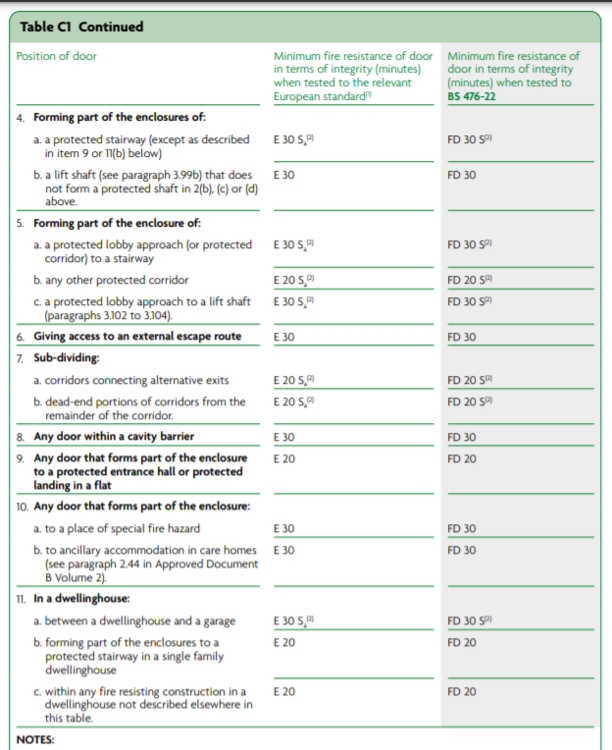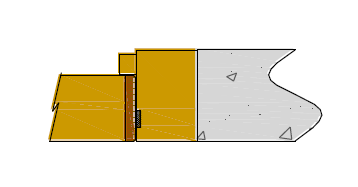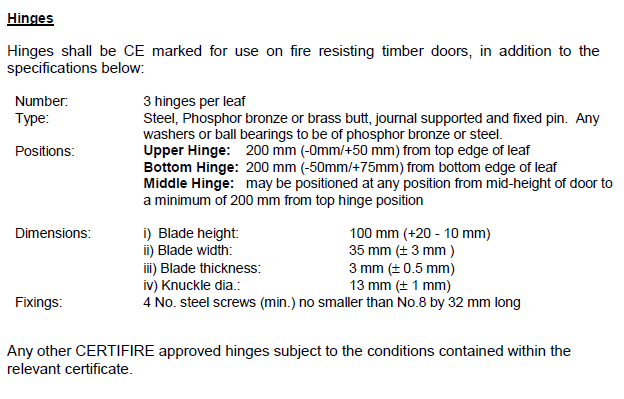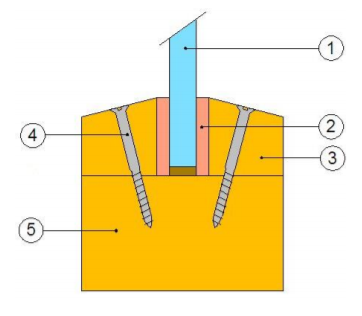-
Posts
476 -
Joined
-
Last visited
Everything posted by Neil ashdown
-

Need clarification around firedoors.
Neil ashdown replied to Dan E's topic in Fire Doors and Accessories
If you take the risk, one consequence could be a problem if you decide to sell the house. Another consequence could be a problem if there's a fire. -
As you say, an auto-drop seal will not solve the 'soup-bowl' issue. And a static door bottom seal will either not fully seal the gap or cause the door to bind on the step. So there's a choice; fire door compliance or fire door non-compliance (BS8214). In my experience, non-compliance seems to be the popular choice.
-
Judging this in isolation. This defect appears to have been caused by the fixing screw being inserted without sufficient piloting. Fortunately, the split in the hardwood lipping appears to be slight. If the this is a new door installation, then the defect should not be accepted. The door should be repaired by re-lipping in accordance with its certification (if its a fire door). If the door is existing and say been there since the building was built, then ask yourself how long has it been like this? Let's say the answer is two years. Has the defect got worse in those two years? YES or NO From the picture, it looks like the answer could be no, so you could justify filling with acrylic wood filler and monitoring the defect.
-
Ha Ha......This is fire doors we are talking about. Thanks.
-

Fire doors in a domestic 3 storey house
Neil ashdown replied to a topic in Fire Doors and Accessories
Table C1 at page 138 of Approved Document B of the Building Regulations deals with requirements for fire resisting doors in dwelling houses with loft conversion https://assets.publishing.service.gov.uk/government/uploads/system/uploads/attachment_data/file/937931/ADB_Vol1_Dwellings_2019_edition_inc_2020_amendments.pdf For information about hardware / ironmongery for fire doors, consult the guidance document 'Code of Practice -Hardware for Fire & Escape Doors' at http://www.firecode.org.uk/ -
Metal fire doors do not have the same inherent properties of insultation and char behaviour as timber fire doors, therefore thickness alone is not necessarily a guide to fire performance. Contact the DHF https://www.dhfonline.org.uk/ for a copy of the guidance documents 'Metal Fire Door-set Verification' and ' Metal fire doors Code of Practice'
-
Carry out a risk assessment (RAMS). Is the door small or large / light or heavy?
-
My advice would be to not fit a full length mirror to a wooden door due to the weight of the mirror and its effect on the hinges and fixings as well as the shape (tendency to bow/twist) of the door over-time. In terms of it being a fire door, clearly where the weight of the mirror does have such an effect this could mean that in a fire the door could lose its stability (eg. warp, twist or bow) and cause the door to fail prematurely.
-
The decision would depend on the following factors: 1) How critical are the fire doors to life safety? 2) How critical are the fire doors to asset protection, where this is an important requirement? 3) Are the doors of historical importance or can they be replaced? 4) What level of competence is available in terms of the knowledge and skills of the maintainer/repairer? It is important to understand that repairs to fire doors can sometimes void the product certification for the fire performance of the door. However, the door should be maintained in accordance with the requirements of Article 17 of the Regulatory Reform (Fire Safety) Order 2005 so the maintainer/repairer should justify the decisions they make in terms of any repairs they undertake. Where the decision is made to replace rather than repair, a suitable fire door should be selected to avoid replacement with an inferior door.
-

intumescent strip from previous up grade
Neil ashdown replied to a topic in Fire Doors and Accessories
The intumescent strip is best fitted in the door frame jambs and head so that it opposes the edge of the door leaf in the closed position. It should oppose at the mid point of the door leaf's thickness. Alternatively, the strip may be fitted at mid thickness to the vertical and top edges of the door leaf. Sometimes, if the doors have a higher fire rating there are two seals instead of one and on some double leaf doors there is sometimes a seal on both leaves at the meeting edge, but fitted offset rather than the seals opposing each other. A fire door leaf or fire door frame should not be grooved for a seal if one is not to be fitted. This is because it could potentially affect the fire performance of the seal fitted opposing the unoccupied groove. A fire door leaf should be a good fit in it's frame and should not rattle in it's frame in the closed/latched/locked position. Where a client has doubts about a newly installed fire door they should raise this with the installer. If necessary they could engage a competent fire door inspector to advise as a third party. -
Fire door inspectors and fire risk assessors will be looking for a CE mark and a minimum durability grade 11 when they inspect the hinges of fire doors. This is because CE marking of construction products that have harmonised standards became a legal requirement from 2013. Therefore since that date manufacturers have been required to apply a CE mark to hinges that are used on fire doors. However, current building regulations require that hinges are: https://assets.publishing.service.gov.uk/government/uploads/system/uploads/attachment_data/file/937931/ADB_Vol1_Dwellings_2019_edition_inc_2020_amendments.pdf So if your fire door is a new one the hinges should carry the CE mark. However, it may be that your fire door was installed before the date when CE marking became a requirement, in which case the hinges may not be marked. What is important is that the hinges on your fire door meet the requirements of the door leaf manufacturers installation data sheet. This is because when installing a fire door it is important to replicate what was tested in the furnace. Here is a typical manufacturer's requirement for an older fire door: And here is one for a modern fire door: Clearly, when replacing hinges you should replace them all at the same time with the latest (therefore CE or UKCA marked) version of those hinges. There's more information in the Code of practice: Hardware for Fire & Escape Doors at https://docplayer.net/22285424-Code-of-practice-hardware-for-fire-and-escape-doors.html
-
You could contact the Housing Standards officer at your local authority. From what you say, it appears your door does not comply with government advice.
-
The system, as it is, tends not to be helpful to private flat owners. You could start by discussing the matter with your local Certificated Fire Door Inspector. They may be able to help.
-
You should purchase the glass, gasket materials and glazing beads (retention system) as a complete system. Example of a fire rated glazing system below: 1) FR glass product, 2) gasket/setting system, 3) beading system, 4) fixings (including sizes and centres) and 5) framing. Start by selecting a suitably fire rated glass and consult the relevant fire resistance performance certification for details of the gasket/beading/fixings system that is necessary to suit that particular glass. Various certifications can be found at https://www.warringtoncertification.com/certified-companies/certifire/glass-and-glazing for example.
-
First find out who manages the block and report the issue to them. Depending on the seriousness of the issue in terms of safety the Responsible Person could be in breach of the Fire Safety Order 2005, if they fail to address the issue. You could seek advice from https://www.gov.uk/government/organisations/regulator-of-social-housing/about if you are a tenant or the local fire and rescue service (Community Fire Safety Officer) if you own the flat.
-
Have you identified which doors need to be fire doors and why?
-
This information may help you to carry out your fire risk assessment https://www.london-fire.gov.uk/safety/the-workplace/pubs-bars-and-clubs/
-
I would certainly have the doors repaired, if not replaced. But for advice contact the door manufacturer. Otherwise contact the Door & Hardware Federation to find a competent maintenance & repairs company metal fire doors.
-
The requirements are that: The fire door must self-close completely and reliably to the door frame rebate stop. The maximum delay for self-closing, according to EN1154, is 25 seconds. Information at http://firecode.org.uk/Code of Practice 2009 Issue 3.pdf If a fire door is banging shut, this matter should be reported so that a competent maintenance operative can adjust or replace the self-closing device. It could be that the self-closing-device has lost fluid or that adjustment of the controls is required.
-
The requirement for smoke seals is based on the needs in terms of fire strategy at the building. For example, fire escape routes would benefit greatly from restricted spread of smoke as would sleeping areas. Having the door type (steel/timber) alone reveals nothing about any requirement for smoke seals.
-
Clearly, if you remove a lock and leave a hole in the door it should be repaired. This can be done by a competent person but the door manufacturer's fire performance certification is likely to be void due to the lack of evidence of fire resistance performance in a 'repaired state'.
-
Current building regulations are here https://assets.publishing.service.gov.uk/government/uploads/system/uploads/attachment_data/file/937931/ADB_Vol1_Dwellings_2019_edition_inc_2020_amendments.pdf Appendix C Fire Doors, paragraph C5 deals with self-closing fire doors:
-
Consult a competent fire door inspector. They would examine the fire door assembly and then be able to advise about what can be done to improve its likely fire/smoke resistance performance. But remember, even after the works have been done a nominal door is still a nominal door.
-
The maximum gap at the threshold for a timber-based fire door should be 10mm. Therefore you may need to fit a ramped threshold plate to the floor. Where restricted smoke spread is a requirement the maximum threshold gap is 3mm. Therefore, you may need to re-lip the bottom edge of the door, fit a ramped threshold plate and a threshold smoke seal.
-
There is no reference to the use of PVC architraves in the BS 8214: 2016 Timber-based fire door assemblies - code of practice. So with reference to Flat Entrance Doors (often composite construction) I would consult the door manufacturer. Doors in communal areas are likely to be timber-based doors, therefore I would use timber-based architraves.








